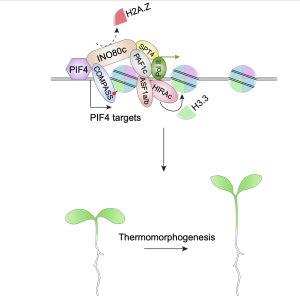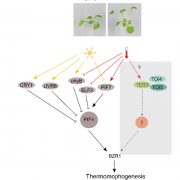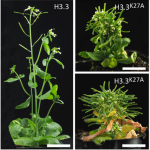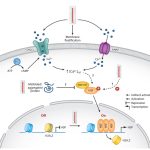Coordinated histone variant H2A.Z eviction and H3.3 deposition control plant thermomorphogenesis
 The effect of temperature on plant morphology is known as thermomorphogenesis. The phytohormone auxin is important for thermo-induced cell elongation. In Arabidopsis thaliana, Phytochrome-Interacting Factor 4 (PIF4) forms the central hub of the thermal response pathway and directly regulates auxin synthesis gene expression at high temperature. The activity of PIF4 is linked with chromatin regulation, and thus temperature influences epigenetic gene regulation in A. thaliana. PIF4, together with a chromatin remodeller INO80, is involved in H2A.Z eviction from the thermo-responsive gene loci in response to warm temperature. However, H2A.Z eviction isn’t sufficient for active transcription, and H2A.Z eviction is sometimes linked with active histone mark H3K4me3. Thus, H2A.Z eviction-induced gene regulation isn’t fully understood yet and further studies are essential for better understanding. Here, Zhao et al. showed that H3.3 deposition is required at warm temperature for thermomorphogenesis and RNA Pol II activity at PIF4 targets. The authors also showed that INO80 and ELF7 regulate H3.3 enrichment at PIF4 targets and that H3.3 is important for the H2A.Z eviction-induced gene activation. In a nutshell, Zhao et al. explain a striking association between H2A.Z eviction and H3.3 deposition leading to transcription activation at warm temperature and suggest a significant role of nucleosomal dynamics in the context of thermal response in A. thaliana. (Summary by Sourav Mukherjee @SouravBiotech) New Phytol. 10.1111/nph.18738
The effect of temperature on plant morphology is known as thermomorphogenesis. The phytohormone auxin is important for thermo-induced cell elongation. In Arabidopsis thaliana, Phytochrome-Interacting Factor 4 (PIF4) forms the central hub of the thermal response pathway and directly regulates auxin synthesis gene expression at high temperature. The activity of PIF4 is linked with chromatin regulation, and thus temperature influences epigenetic gene regulation in A. thaliana. PIF4, together with a chromatin remodeller INO80, is involved in H2A.Z eviction from the thermo-responsive gene loci in response to warm temperature. However, H2A.Z eviction isn’t sufficient for active transcription, and H2A.Z eviction is sometimes linked with active histone mark H3K4me3. Thus, H2A.Z eviction-induced gene regulation isn’t fully understood yet and further studies are essential for better understanding. Here, Zhao et al. showed that H3.3 deposition is required at warm temperature for thermomorphogenesis and RNA Pol II activity at PIF4 targets. The authors also showed that INO80 and ELF7 regulate H3.3 enrichment at PIF4 targets and that H3.3 is important for the H2A.Z eviction-induced gene activation. In a nutshell, Zhao et al. explain a striking association between H2A.Z eviction and H3.3 deposition leading to transcription activation at warm temperature and suggest a significant role of nucleosomal dynamics in the context of thermal response in A. thaliana. (Summary by Sourav Mukherjee @SouravBiotech) New Phytol. 10.1111/nph.18738





